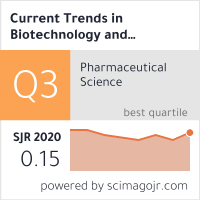Studies on Phytochemical Screening, GC-MS Analysis and their Antibacterial Property Against Vibrio cholerae
DOI:
https://doi.org/10.5530/ctbp.2023.3s.46Keywords:
Cinnamomum verum, Phytochemicals, GC-MS analysis, V. cholera, AzithromycinAbstract
In the current study, two different MTCC strains of Vibrio cholera, 3904 and 3906, were used to determine the anti-bacterial properties of Cinnamomum verum (C. verum) leaves (Family: Lauraceae). This was done through qualitative phytochemical compound screening and quantitative identification of volatile compounds using gas chromatography and mass spectrometry (GC-MS). Methanolic extract was subjected to phytochemical screening in order to determine the active components. Through qualitative examination revealed that the substance contained alkaloids, total carbohydrates, cardiac glycosides, flavonoids, glycosides, phenols, saponins, and tannins. Due to the abundance of phytochemical agents in the extract, GC-MS experiments were conducted. Based on their retention times and coverage percentages in mass spectra, these studies identified 42 volatile chemicals. The maximum zone of inhibition for the antibacterial activity of methanol extract were 15.9 mm for the V. cholera MTCC 3904 strain and 16.3 mm for the V. cholera MTCC 3906 strain, respectively, at concentrations of 100μL, Azithromycin showed 22.30 mm, a positive control, at a dosage of 30μg. Total antibacterial activity was determined to be 15.05 ±1.15 mm and 15.10±1.15 mm, respectively, in the examined bacterial strains. These values are equivalent to conventional azithromycin. In conclusion, C. verum can be a potential therapeutic agent against V. cholera strains, this is due to strong antibacterial nature of active biomolecules present in the medicinal plant.



